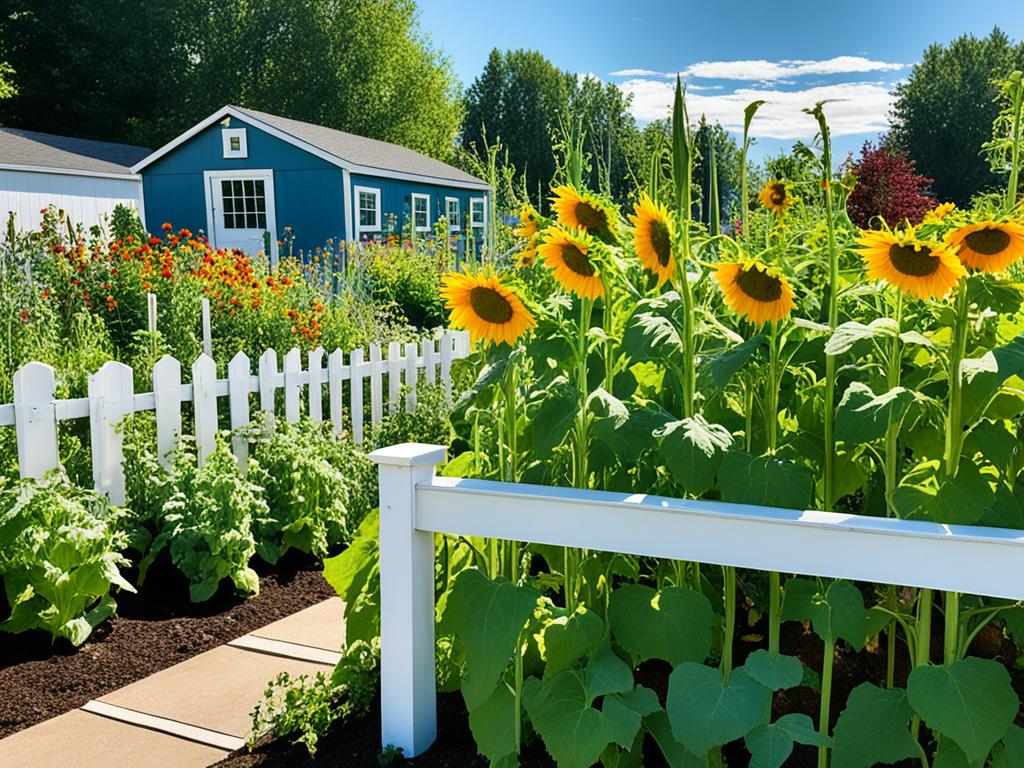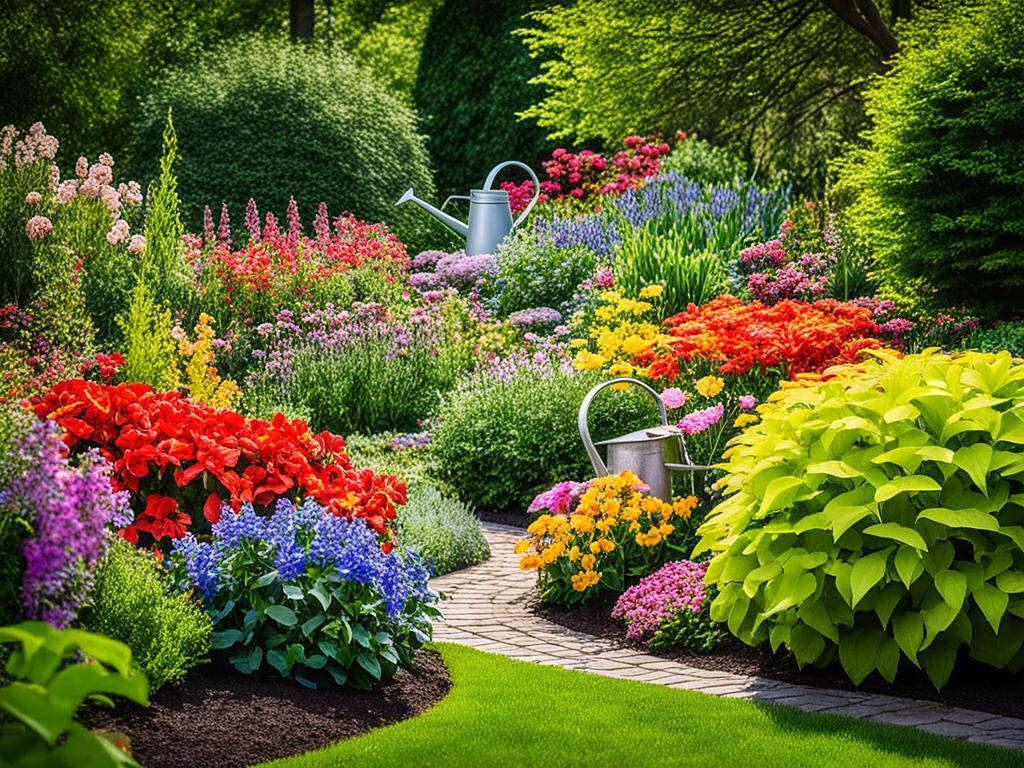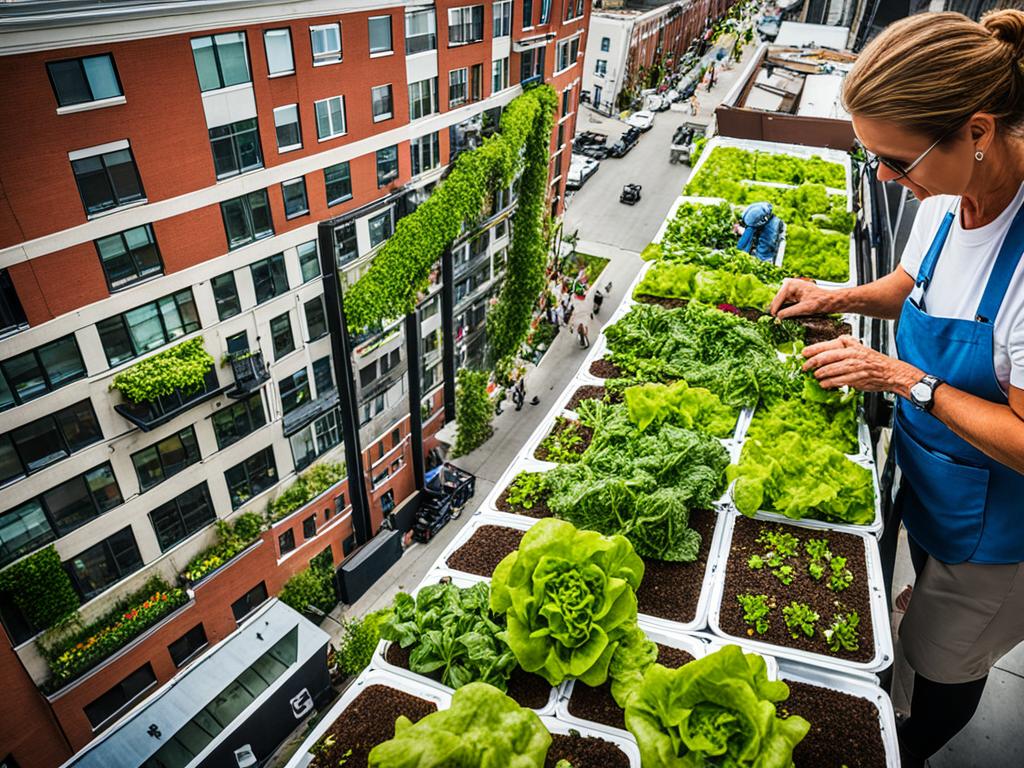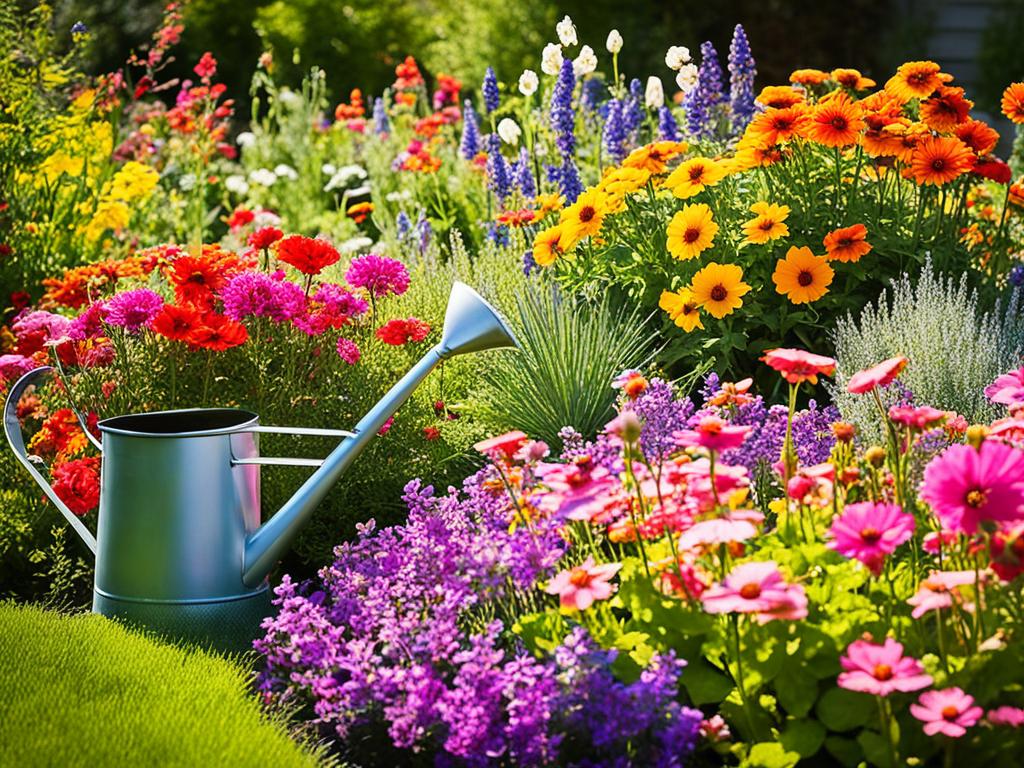Are you ready for a journey full of satisfaction and beauty? Gardening lets you grow food and create flower displays. But which will you choose? Harvest fresh, organic veggies from your backyard? Or enjoy growing flowers, filling your yard with color and scent?
Whichever path you pick, follow organic gardening. Learn about sustainable agriculture, urban farming, and more. Let’s use nature’s gifts to create your dream garden.
The Benefits of Gardening
Gardening is more than a hobby, it’s rewarding and beneficial. It’s good for people and the planet. You get to enjoy fresh food and a healthier lifestyle. We’ll look at the benefits, like being organic and eco-friendly, and we explore ideas like urban farming and making permaculture part of your life.
Connecting with Nature
Gardening lets us get closer to nature. Caring for plants and seeing them grow is peaceful. It’s a break from screens, giving us time in the outdoors. This way, we can truly enjoy the world around us.
Nurturing Sustainable Agriculture
Gardening is a big help to farming in a green way. We avoid toxic chemicals by gardening organically. This is good for the soil and helps bugs that help plants. It’s all about working with nature to keep everything in balance.
Promoting Health and Well-being
When we grow our food, we eat better. We choose what to grow, which means healthier meals. Being in the garden is good exercise and gets us sunshine. This is great for our health and happiness.
Creating a Sustainable Future
There are cool ideas in gardening like urban farming and permaculture. They make gardening good for the earth. Urban farming brings food closer to us. Permaculture uses smart design to create self-supporting systems. These ideas help us build a better world together.
By adopting organic gardening practices and exploring concepts like sustainable agriculture, urban farming, homesteading, and permaculture, we can enjoy many gardening benefits. At the same time, we help the environment. Whether it’s through nature, sustainable farming, health, or our future, gardening is an amazing, life-changing journey.
| Benefits of Gardening | Keywords |
|---|---|
| Promotes sustainability | organic gardening, sustainable agriculture |
| Encourages healthy eating | organic gardening |
| Connects with nature | urban farming, homesteading, permaculture |
| Nurtures sustainable agriculture | organic gardening |
| Promotes health and well-being | organic gardening, sustainable agriculture |
| Creates a sustainable future | urban farming, homesteading, permaculture |
Getting Started with Vegetable Gardening
Are you excited to grow your own healthy food? Vegetable gardening is a perfect start. It not only feels good but also helps the planet by using natural methods and supporting sustainable farming.
We will show you how to begin your vegetable garden. We will talk about choosing the best vegetables and how to help them grow well all season long.
1. Selecting the Right Vegetables
Pick your veggies based on where you live, your soil, and what you like. Choose vegetables that do well in your area and taste great. Beginners often go for tomatoes, lettuce, peppers, zucchini, and carrots.
2. Preparing the Soil
Good soil is key to a great garden. Clear it of weeds and debris. Then, make it soft with a fork or tiller. Adding compost or manure makes the soil full of nutrients, helping your plants grow strong.
3. Planting Your Vegetables
Each vegetable has its planting needs. For some, like tomatoes and peppers, start them indoors first. For others, like carrots and beans, plant them right in the soil.
4. Watering and Maintenance
Your plants need regular watering. Check the moisture in the soil, and water more in dry times. Weeding and keeping pests away are also important for a healthy garden.
Try to avoid chemicals. Natural ways to keep pests off, like planting certain plants together, are good choices.

5. Harvesting Your Produce
When your plants are ready, it’s time to pick the fruits and veggies. Look at your plants closely. Their signs, like color or firmness, will tell you when they are ripe for picking.
Gardening teaches you a lot as you go. Learn from your garden and reach out for advice or ideas. Gardening friends and books can offer great tips.
| Vegetable | Sunlight Requirements | Soil Type | Planting Time |
|---|---|---|---|
| Tomatoes | Full Sun | Well-drained, fertile soil | Spring |
| Lettuce | Partial Shade | Moist, well-drained soil | Cool seasons (spring and fall) |
| Peppers | Full Sun | Well-drained soil | Spring |
| Zucchini | Full Sun | Rich, well-drained soil | Spring |
| Carrots | Full Sun to Partial Shade | Loose, well-drained soil | Cool seasons (spring and fall) |
Be patient and learn as you go. Growing your own veggies with a little know-how is rewarding. Now, get your hands dirty and watch your garden grow!
Creating a Stunning Flower Garden
Flower gardens bring color and beauty to our lives. In this guide, we’ll show you how to make a garden that’s admired by all. We’ll help you pick the right flowers and plan your garden for maximum impact.
Flower Selection – The Key to a Colorful Garden
There are many flowers to choose from, whether you like flowers that bloom every year or ones that come back. Think about where you live and how much sun your garden gets. This will help you pick flowers that will do well.
Try mixing different colors, shapes, and sizes of flowers for a lovely look.
“Flowers are the music of the ground. From the earth’s lips, spoken without sound.” – Edwin Curran
Companion planting is a smart idea. Some flowers work well together. They look good and also help keep each other healthy. For example, some scents can keep pests away. This helps you have a garden that’s full of life.
Soil Preparation – Setting the Foundation for Success
Getting the soil right is key to a great garden. First, clean up the area and loosen the soil. This lets the flowers’ roots grow easily.
Adding things like compost can make the soil better for plants. Make sure the soil drains well, too. Wet soil can harm plants.
Planting and Maintenance – Nurturing your Flower Garden
When planting, follow the instructions you get with your plants. Give each plant enough space and water them well. This helps them start to grow.
Keep your garden clean from weeds and give your plants food. Watch how much water your flowers need. Mulch helps keep the soil nice for your plants.
Deadhead flowers to keep them blooming. Cut out anything that’s not healthy. Keep an eye out for bugs and diseases, and stop them from hurting your plants.

Landscape Design – Creating a Visual Masterpiece
Designing your garden can make it look amazing. Think about flower height, color, and shape. This will make everything flow well.
Adding things like paths and rocks can make your garden interesting. Use natural materials where you can. This gives your garden a timeless appeal.
Also, think about the sun and wind when you place your plants. Protect smaller, delicate plants with larger ones. This makes your garden a better place for all your flowers.
With a bit of planning, loving care, and creativity, you can make a beautiful flower garden. It will bring you happiness and color. Get started today and enjoy the beauty you create!
Maximizing Space with Urban Farming
If you’re short on space, urban farming is a great idea. It’s about growing plants and crops in cities. This can be very rewarding. It provides fresh food, puts you closer to nature, and is good for the Earth.
Container gardening is perfect for small areas. It means growing plants in pots, raised beds, or other containers. This way, you can use even the tiniest spots to grow your own food.
Growing plants up walls or on structures is called vertical gardening. It’s a smart way to use less ground space. This method lets you grow plenty of plants even in a small area.
“Urban farming is great for the planet and for people. It makes us more independent, secures our food, and brings city folks together,” explains Samantha Green, a farming expert.
Rooftop gardens are becoming more common in cities. They’re found on top of tall buildings and in commercial areas. They not only provide a place to relax but also help keep the city cooler and cleaner.

With urban farming, any space can become a green garden. If you have a balcony or a rooftop, try it out. You can grow your own food and beautiful plants. This way, you’ll use space well and feel the joy of nature right in the city.
Embracing Sustainable Practices
Practicing sustainable agriculture means using methods that are good for both our gardens and the Earth. This includes organic gardening, permaculture, and homesteading. They help us grow beautiful gardens while reducing our footprint on the planet. By composting, saving water, and following permaculture and homesteading rules, we make our gardens more sustainable and our world greener.
At the heart of sustainable farming is organic gardening. It avoids synthetic chemicals, preferring natural methods like compost to enrich the soil. These methods protect the environment and support diverse plant life.
“Organic gardening is not just about growing plants; it’s a mindset that respects the interconnectedness of all living things.”
Composting is also crucial. It turns scraps into food for the soil, making it rich. By composting, you reduce waste and keep your garden healthy in a natural way.
“Composting is nature’s way of recycling. It turns waste into black gold for your garden.”
Water conservation is very important in sustainable gardening. Methods like mulching, drip irrigation, and capturing rainwater help save water. This protects the environment while keeping your garden lush and healthy.
Permaculture mimics nature to create sustainable, productive ecosystems. It blends food production with saving energy and proper waste disposal. This way, we can have gardens that care for themselves and are good for the planet.
“Permaculture gives us the tools to design sustainable, productive, and aesthetically pleasing landscapes, while working with nature rather than against it.”
Homesteading is a lifestyle that’s all about being self-sufficient. It includes gardening, keeping animals, preserving food, and using little from the outside world. Homesteaders help their local communities by living this way.
| Sustainable Practices | Description |
|---|---|
| Sustainable Agriculture | Practices that prioritize environmental stewardship and long-term viability of agricultural systems. |
| Organic Gardening | A method of gardening that relies on natural techniques and materials to minimize environmental impact. |
| Permaculture | A design philosophy that aims to create self-sustaining and regenerative systems. |
| Homesteading | A self-sufficient lifestyle that includes gardening, food preservation, and minimizing dependency on external resources. |
Using sustainable methods in your garden supports not just its health but also the Earth’s. It’s a big step towards a future where our planet thrives.
The Joys of Horticulture
Horticulture is both a science and an art. It’s all about growing plants. For gardeners, it’s a thrilling journey, whether you’re just starting or have lots of experience. You can explore the magic of organic growing and flowers in this world. It really is worth the effort.
Discovering the Beauty of Different Plant Species
Finding new plants to grow is horticulture’s fun part. You can pick from all kinds, like bright flowers or green leaves. Each plant makes your garden unique. You might love bright roses, soft orchids, or spice-scented herbs. It’s all about enjoying nature close to home.
When choosing plants, think about your area’s weather and sun. This helps your garden bloom. Try mixing plants to make your own special garden. This way, it shows who you are.
Mastering Propagation Techniques
Learning how to make new plants is key. You can do it from seeds, cuttings, or by dividing. Knowing this, you can grow more without buying.
Learning how to do this for different plants is fun. Some need special care, others not so much. Sharing your plants with others is also rewarding.
Nurturing Plants with Care and Attention
Taking care of your plants is what it’s all about. They thrive when you love them. This includes watering, feeding, and keeping pests away.
Going organic is great for the plants and our planet. Pick eco-friendly ways to care for your plants. This way, your garden is good for the Earth too.
Starting in horticulture means many chances to be creative. In gardens or landscapes, there’s so much you can do. Enjoy horticulture. Create a beautiful garden that shows off right at home.
Conclusion
Gardening offers many benefits, from fresh food to beautiful outdoor areas. If you like growing food or flowers, using organic methods and sustainable farming is key. You’ll find joy and rewards in these gardening practices.
Growing your own vegetables and herbs lets you eat food that’s clean and healthy. It also gets you closer to nature and helps the planet by reducing harmful chemicals. Plus, this promotes local plant and animal life.
A colorful flower garden makes your outdoor space look great and helps bees and butterflies. It’s a chance to be creative with your garden. Use design ideas to turn it into your special place.
Don’t delay, start planting today. Gardening is for everyone, even if you just have a small space. It brings happiness, calm, and a love for the world around us.




